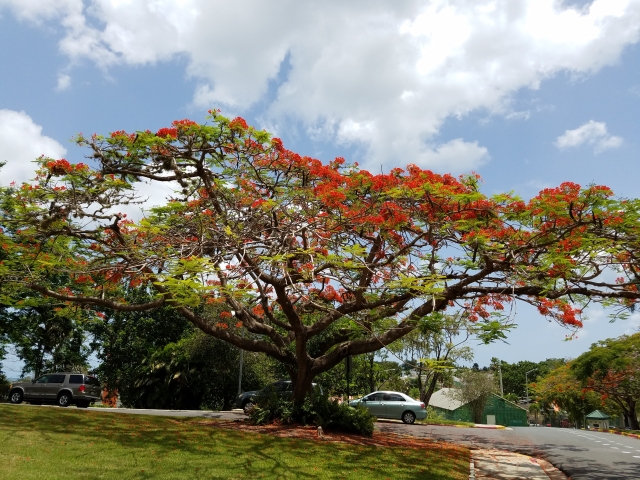An Adventure in Puerto Rico: Research, Rental Cars, and Red Trees
Enviado por Eloise Flora Yount el
Greetings CienciaPR community,
My name is Eloise Yount, and I am proud to say that I have the opportunity of conducting research at the UPRM in the interim period between my third and fourth years as an undergraduate student at the Georgia Institute of Technology. I am pursuing a degree in chemical and biomolecular engineering, and with that degree I plan to lay the foundation for a career focused on sustainable technology/renewable energy development and implementation.
This is my very first time in Puerto Rico, and also my first time this far away from home—a quaint little suburb outside of Atlanta, Georgia. So far, the other research interns and I have taken every opportunity to explore La Isla del Encanto—trips to Crash Boat, various beaches in Rincon, museums in Ponce, and the postcard-worthy Playa Sucia are among the first gems we’ve uncovered on our rental car weekends. Still yet to come is a weekend in San Juan, a trek through El Yunque, some cave crawling, and dip in one of the three bioluminescent bays on the island. My Spanish is improving in baby-steps, although I must say that I’m a little disappointed in my capabilities after years of high school Spanish courses… it’s a work in progress. One of my favorite things about Puerto Rico so far is the frequent sighting of the flamboyant tree, or Royal Poinciana-- a wonderfully obnoxious, possibly invasive species that sports crimson-red flowers across its broadly arched branches.
The main focus of the research I am conducting, as a mentee of Ph.D. Candidate Paul Meza in the computational chemistry lab of Maria Curet, is the analysis of a material called CPL-bpp under the adsorption of CO2. CPL-bpp belongs to a class of compounds known as Metal Organic Frameworks--or MOFs for short--which are a relatively new class of man-made materials that have garnered lots of attention from chemists, material scientists, and engineers in recent years. All MOFs share a few common features: some kind of metal/transition metal atom linked by repeating, modular organic pieces (i.e. lots of carbon), that self-assemble to form a stable, crystal-like framework. Because of typically high porosity within most MOFs, these structures can also feature insanely high void fractions and internal surface areas (the highest recorded surface area in a MOF is just less than 7000 square meters per gram!). Because of these textural properties that MOFs possess and because of their seemingly endless capacity to be manipulated and put together in whatever fashion is needed--say, for new kinds of drug delivery, water treatment, light capture, catalysis, gas separation, etc., scientists and engineers are having a field day dreaming up new kinds of applications for these materials.
CPL-bpp is being studied as a possible material for CO2 capture—and this is where my research comes in. I am using computational techniques (meaning computer simulations) to analyze how the molecular structure of this MOF changes as it adsorbs CO2 into its pores. Do the pores widen? Do they shrink? Does the internal surface area increase with each additional CO2 molecule adsorbed? Do the pillar ligands rotate with increased gas pressure?? Now, I’m sure you’re on the edge of your seat…but you’ll just have to wait until I’m finished with the project to get all the answers.
Until next time,
Eloise









